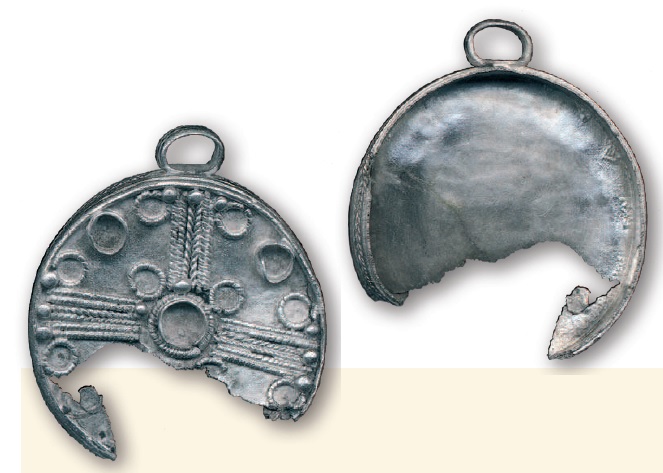UD: November 2019
Some of the most spectacular Celtic archaeological discoveries in recent years have come from the Scordisci hillfort at Zidovar (Banat region) in north-eastern Serbia, which has yielded a vast array of artifacts of various materials, mostly dating to the 2/1 centuries BC.
The hill at Zidovar – site of an important Celtic (Scordisci) hillfort from 3-1 century BC
Silver finger rings, brown bear tooth talisman, and silver bird pendants from the Zidovar hillfort (2/1 c. BC)
(See also: https://balkancelts.wordpress.com/2014/07/19/celtic-scordisci-bird-pendants/)
Among the most exquisite artifacts from Zidovar are 2 lavishly decorated silver jewelry boxes, and the lid of a third such box decorated with 4 spokes, thus constituting a solar/Taranis wheel.
Silver lid of a jewelry box from Zidovar (2/1 c. BC)
(see also: https://balkancelts.wordpress.com/2014/08/14/a-taranis-belt-buckle-from-dalj-eastern-croatia/)
Silver jewelry box from Zidovar
Construction of the complete jewelry box from Zidovar
All 3 jewelry boxes have a high percent of silver (average values over 95 wt%). Copper is the main alloying element (average values from 1.5–4 wt%). Lead contributes less then 1 wt%, and tin was not detected in the metal of any of the boxes.
(after Živković J., Rehren T., Radivojević M., Miloš Jevtić M. and Jovanović D. (2014) XRF characterisation of Celtic silver from the Židovar treasure (Serbia). In: UNDER THE VOLCANO. Proceedings of the International Symposium on the Metallurgy of the European Iron Age (SMEIA) held in Mannheim, Germany, 20–22 April 2010. p. 157-174)
The chain used on the jewelry box is also noteworthy. These are of the ‘Foxtail’ type, similar examples of which are to be found in a number of necklaces from Zidovar and other Balkan Celtic sites.
Scordisci ‘Foxtail’ necklaces from Zidovar
(see also: https://www.academia.edu/7915664/Celtic_Foxtail_Necklaces )
Such chains are believed to have developed from Hellenistic prototypes, and the merging of Hellenistic and Celtic artistic models and influences on the Balkans from the late 4th century BC onwards resulted in a spectacular fusion of forms culminating in unique compositions in glass, ceramic and metal.
Celtic kantharos of the ‘Danubian Type’ with anthropomorphic decoration from Blandiana, Alba County, Romania (3rd c. BC). Such kantharoi were developed by the Balkan Celts from Hellenistic prototypes.
(see: https://www.academia.edu/5992553/Late_La_T%C3%AAne_Ceramic_from_Bulgaria)
Celtic gold ‘Janus Head’ pendant from Schumen region, Bulgaria (3rd c. BC)
(see: https://balkancelts.wordpress.com/2013/07/01/the-archaeology-of-heads/)
Full view of the Celtic jewelry box with ‘Foxtail’ chain from Zidovar (2/1 c. BC)
The sheer amount and diversity of artifacts discovered at Zidovar logically indicates that this area was one of the key centers for the production of Balkan Celtic jewelry in the late Iron Age. From a wider perspective, the level of technical accomplishment and craftsmanship to be observed on these and other recently discovered Balkan Celtic works of art is on a par with anything produced by ‘classical’ cultures, and the treasures from the Scordisci hillfort at Zidovar once again testify to the artistic and material sophistication which had been achieved by European Celtic society prior to its systematic destruction by Rome.
Mac Congail









It makes one proud to be Celtic.